EDITOR’S NOTE: Yesterday came the welcome news that my old friend and mentor Mark Gruenwald has been inducted into the Will Eisner Comic Book Hall of Fame, a well-deserved honor for a great talent in comics who left us far too soon. Let’s take a look back at my favorite of Mark’s works, his landmark run on CAPTAIN AMERICA…
It was in July 1985 that writer Mark Gruenwald took the reins on CAPTAIN AMERICA, beginning a mammoth 106-issue run that would last over 10 years, a remarkable achievement in itself. It’s become popular to dismiss Gruenwald’s version of the character as long-winded and speechifying, but a closer look at the comics reveals that not to be the case. Granted, Gruenwald occasionally had a tendency to give Cap some slightly stilted dialogue, but to my mind, it served a purpose. More than anything else, Captain America embodied confidence. Confidence in the justness of his cause, in his belief in his country and in his own abilities. Cap wouldn’t hesitate to leap into action when necessary, but he also wouldn’t jump in recklessly, and to properly characterize him as confident but not impulsive, he had to give his opponents a chance to think about what they were doing and surrender first. Which, if you’re not paying attention to the “why,” can easily be interpreted as “Cap making speeches.”
Even more important, this characterization of Cap as the epitome of self-confidence served as the perfect manner in which to cut the legs out from under him in what was Gruenwald’s most popular and critically acclaimed story arc on the series, “Captain America No More!”, from CAPTAIN AMERICA #332 to #350.
Here Steve Rogers is summoned before a Presidential commission and informed that, under the terms of his service contract with the United States Army signed during World War II, he is obligated to serve in an official capacity until such time that he’s relieved of duty, and that the uniform, shield and identity of “Captain America” are property of the United States government. If he chooses not to follow orders and work directly for the Commission, then they will take back the uniform and find someone else to do so.
Cap struggles with the decision, feeling that working for the government directly might force him to compromise his personal ideals, while at the same time being unwilling to go public and engage a lawyer to fight the decision, feeling that it would be disloyal to drag his nation’s government through the mud. At the last, Cap makes his decision, feeling that “Captain America” has come to represent the American people, and the American dream: to become that which you dream of becoming. Since working for the government might require him to go against his personal ideals, he hands over the costume and shield and walks away.
It’s important to remember that in 1987, not every superhero had been replaced by someone else and returned again, so this story really had a dramatic impact. With no Internet and no comics press to spoil the story for readers, the less jaded fans of yesterday were sandbagged by this bombshell, and many were not at all happy, as the letter column in succeeding issues can attest, with many a negative, insulting letter being printed (a credit to the even-handed editorial by Don Daley).
This story’s portrayal of Cap also highlights what would become a Gruenwald trademark: a protagonist with such a highly developed code of ethics that it works to his detriment, at least in the short term. If Cap were to have responded as most of us would have, with righteous indignance, going public with the Commission’s demands, or even going over their heads to the President himself, he would most likely have never lost his identity. Instead, Cap adheres to what he believes to be morally right, and gives up that which he loves the most. It’s a very old-fashioned, almost Job-like notion, that one must suffer for one’s moral code if it’s to have any value, and it’s one we’ll see again and again in Gruenwald’s works.
As Steve Rogers departs the series, a new Captain America is enlisted: John Walker, formerly Cap’s jingoistic adversary the Super-Patriot. Blindingly patriotic, Walker immediately accepts the government’s offer to become the new Captain America, despite the objections of his sleazy manager and the fact that two of his three partners (all of whom, including Walker, have been artificially enhanced with superhuman strength and toughness) are deemed security risks and not allowed to come on board with Walker.
Walker and his remaining partner, Lemar Hoskins, are set upon an intensive training regimen before their public debut as the new Captain America and Bucky, including workouts with the former Brotherhood of Evil Mutants (then working for the government as “Freedom Force”) and training sessions with jailed supervillain the Taskmaster, who with his photographic reflexes is probably the only man alive other than Steve Rogers who can instruct the new Captain America in the fine art of shield-throwing.
While Walker and Hoskins get used to their new uniforms, it’s over three months later that we catch up with Steve Rogers, who’s been wandering the country in his van brooding over his decision. When a group of Steve’s former partners (the Falcon, Nomad and Demolition Man, or D-Man, a neophyte wrestler-turned-superhero) grow concerned about him, they follow his trail and catch up with him, where he’s just decided to return to his life as a superhero, just without the identity and costume of Captain America. Luckily, D-Man (who’s stinking rich from his wrestling career) had commissioned the design of a new uniform for Rogers, who now calls himself merely “The Captain.”
Rogers’ new uniform is interesting from a symbolic standpoint (as pointed out by a correspondent to the CAP letters pages). Rather than his traditional red, white and blue (which he’s prevented from wearing by a government restraining order), Rogers is dressed in red, white and black, with the darkness perhaps representing his conflicted nature. There’s a flaglike design on the front, but with a black star over the breast, almost suggesting that Rogers’ very heart has been torn from him. And on the back of the uniform, the star reappears in white, as if he’s been stabbed in the back by his patriotism.
The CAPTAIN AMERICA series diverges at this point with two separate but equal storylines, following Steve Rogers and his partners’ adventures on the road, and the new Captain America and Bucky in their missions for the government. Bucky, by the way, is quickly given a costume and name change to Battle Star, after it’s pointed out that A) referring to a grown black man by the name of a dead white teen is a little disrespectful and B) “buck” is a derogatory term for a black man in some parts of the country, an unfortunate fact that neither Mark Gruenwald nor anyone else at Marvel was aware of. To Mark’s credit, he incorporated the incident into the story, with the increasingly confident and assertive Lemar Hoskins demanding a change in name and costume.
While Steve Rogers and company contend with a hostile takeover of the corporate supervillain team the Serpent Society (culminating in a plot by the Viper to poison Washington D.C.’s water supply with a snake mutagen, which leads to Rogers facing off against the government in a very tangible way, grappling with Ronald Reagan in the White House, who’s been transformed into a snake-man.), Walker finds that the role of Captain America is much tougher to fill than he had anticipated, accidentally killing a supervillain he and Hoskins had been sent to detain.
When the new Captain America and Battle Star are introduced to the world at a press conference, they’re interrupted by their former partners (now calling themselves “Left-Winger” and “Right-Winger”), who reveal Walker’s real name and birthplace to the nation. Not long after, a right-wing fundamentalist terrorist group known as the Watchdogs (whom Walker had busted in his first case as Captain America) kidnaps Walker’s parents and demands that he show up and give himself up in exchange. Once more, here we see Gruenwald veer off from the norm in shocking directions.
Walker arrives to find his parents still alive and lets the Watchdogs lynch him, then breaks free and attempts to take down the terrorists before they can kill his parents. Unfortunately, he’s not quite fast enough…
Driven into a rage at the sight of his parents’ murder, Walker snaps and goes into a killing spree, tearing apart the terrorists with his bare hands, and loses touch with reality, as shown here in this disturbing coda.
Walker then spirals further into darkness, taking down a group of mutant resistance fighters with brutal force, then going after his former partners, whom he blames for the death of his parents. Walker beats the two men to a pulp at a gas refinery, then leaves them tied to a fuel tank and ignites the fuel, giving the now nearly sociopathic Captain America a slight moment of satisfaction.
What Gruenwald is accomplishing with this storyline is a clever device later used by DC on their much more publicized “Death of Superman” and “Knightfall” storylines: defining the hero by showing what he’s not — by stripping him of his rightful place, and replacing him with a pretender who can’t (or won’t) measure up. For all the talk of wanting to see a tougher, less “boy-scout-like” Captain America, the scenes of Walker in the Cap uniform committing murder and carnage quickly dispel that desire. It just looks wrong.
The two Captains finally meet in CAPTAIN AMERICA #350, after Battle Star has called Steve Rogers in to help rescue Walker from a bungled mission at the North Pole. Rogers helps Battle Star recover his partner, but not without cost: the presumed death of his own partner D-Man, in a deliberate parallel to the death of Bucky during Cap’s final WWII mission.
(This, I thought, was the biggest misstep in the entire arc, as D-Man is portrayed throughout as Cap’s most loyal and valued partner, and Cap, who generally doesn’t handle the death of partners well at all, seems to get over the death of his friend practically overnight, and doesn’t even think about it again for years.) The hospitalized Walker is lured to a Washington, D.C., office building by a phone call promising to return his shield to him, which Rogers had taken in the mission at the North Pole. Rogers’ investigation of the Commission that originally fired him leads him to the same place, where he discovers the puppeteer behind the entire affair: Who else but Cap’s arch-enemy the Red Skull?
The Skull, whom Cap had thought dead of old age, had actually had his brain transplanted into a cloned copy of Steve Rogers’ body, and had set out to ruin Cap in a whole new way, by manipulating the Commission through highly placed lackeys, arranging to have him fired and replaced, and seeing to it that the new Captain America became a murderous lunatic (being the mastermind behind the murder of his parents and practically all of the foes Walker had contended within his career as Cap), permanently besmirching the image that Steve Rogers had spent his entire life building. The Skull then sets the now enraged and irrational Walker loose on Rogers, and the two go head to head for the first time in the series.
Artist Kieron Dwyer (whose art style has dramatically changed since his days on CAPTAIN AMERICA) does an excellent job with the 7-page fight sequence between Rogers and Walker, effectively portraying Walker’s insanity and Rogers’ surge of returning confidence.
In fact, it must be noted that throughout the series, Dwyer had taken pains to consistently draw John Walker as a recognizably different man in the Captain America uniform, a detail which may have slipped by unnoticed until their first meeting here. Rogers defeats the much more powerful Walker, and just as the returned Red Skull is about to dose Rogers with his Dust of Death, a shield throw from Walker causes it to backfire, permanently shriveling the Red Skull’s once handsome face into, well, a red skull.
With the Skull’s manipulations revealed to the rest of the Commission, Rogers is immediately offered the Captain America identity back, which he is at first reluctant to accept, before being convinced by Walker that the name and shield are rightly his.
Steve Rogers regains his calling as Captain America, having triumphed without compromising his principles or betraying his moral code, as Gruenwald notes in the story’s final moments: “He’s back. He did it his way. And it feels right.”
The “Captain America No More!” storyline was collected in trade as THE CAPTAIN, and is well worth seeking out at your local comic shop or convention.
While ethics and morality were a part of the subtext in Gruenwald’s CAP run, they played a much more prominent role in Gruenwald’s most well-known work, SQUADRON SUPREME. But we’ll get to that next week…

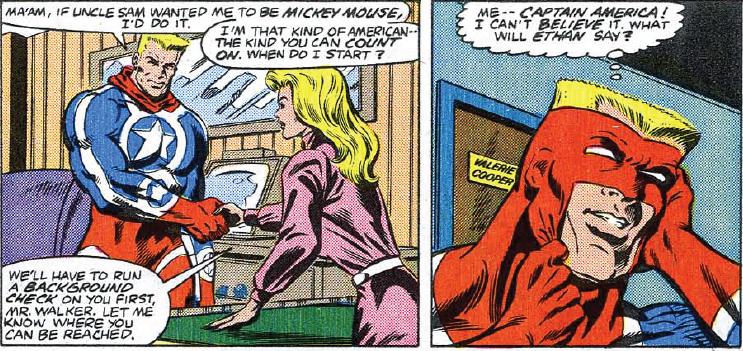
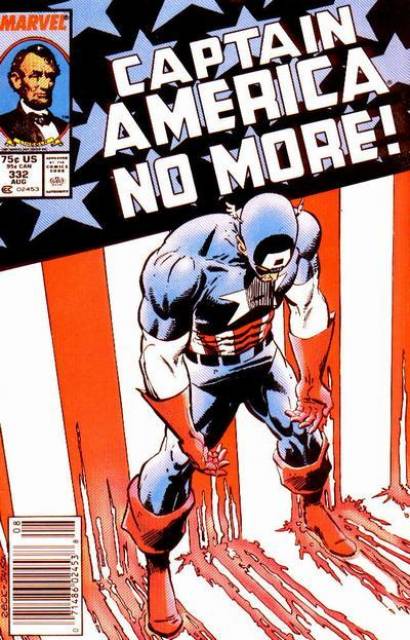
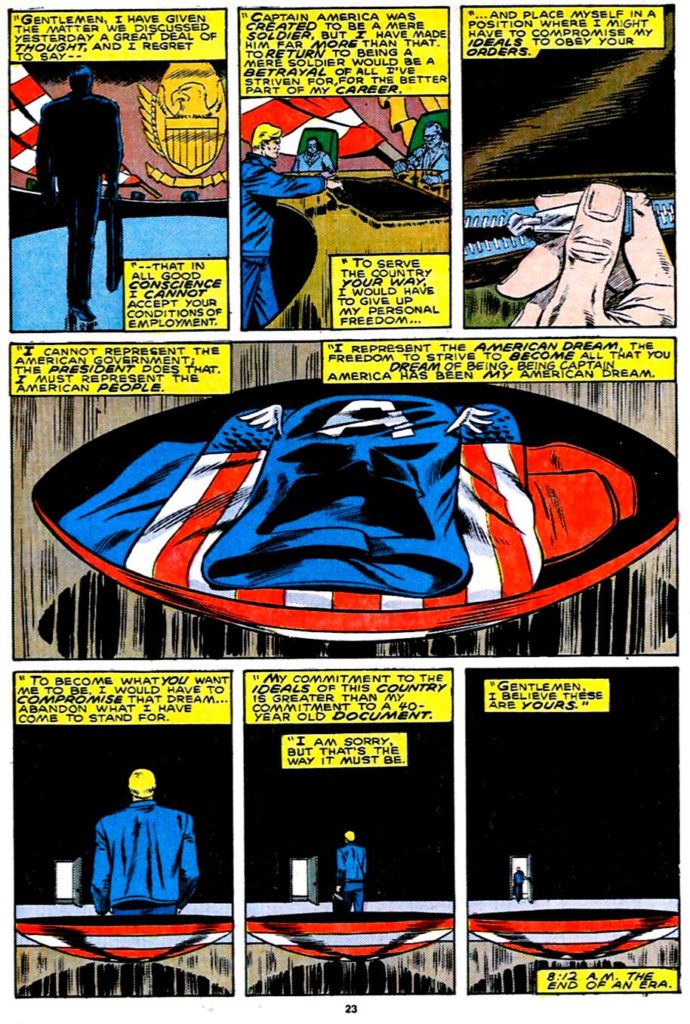

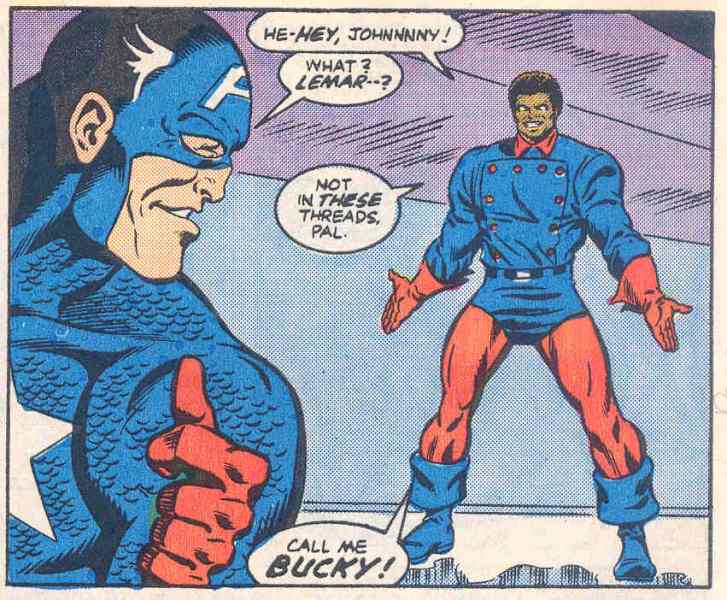
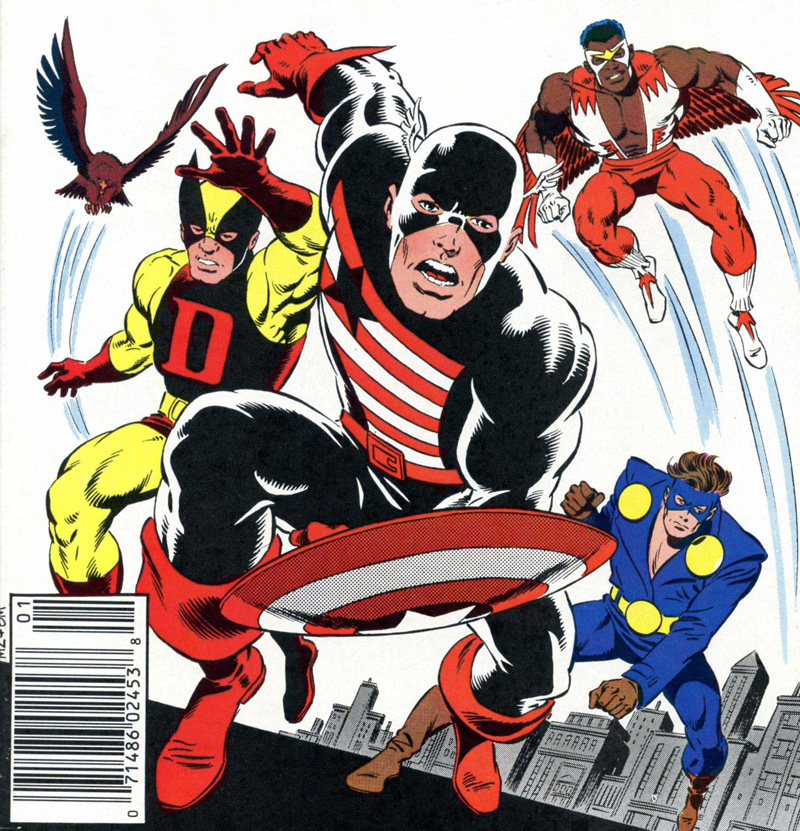
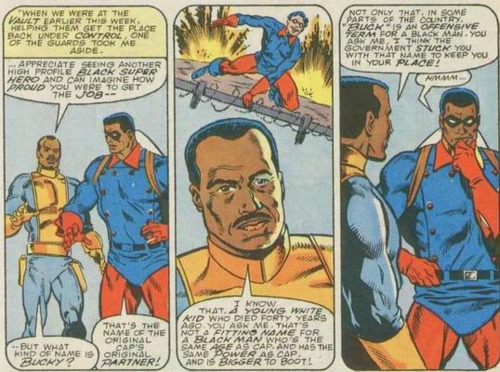
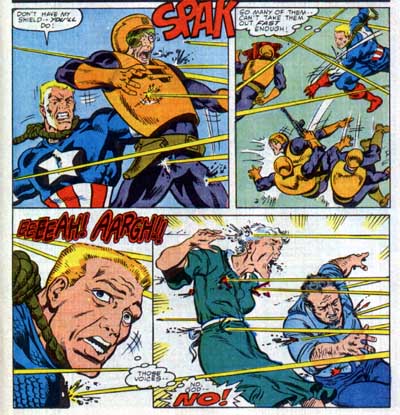
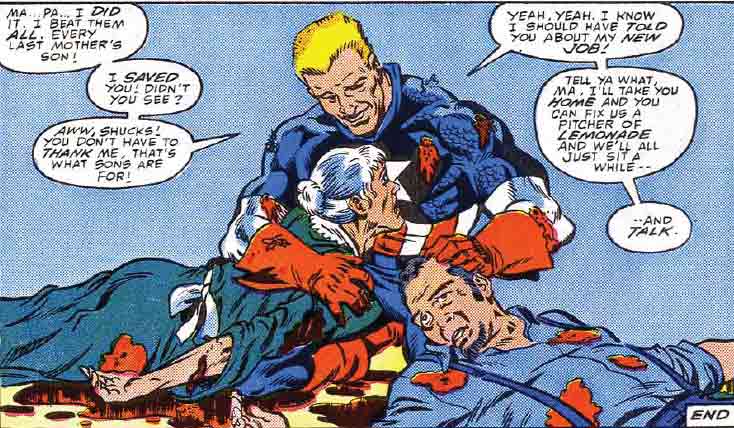
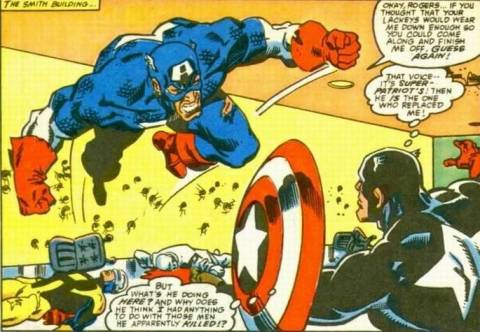
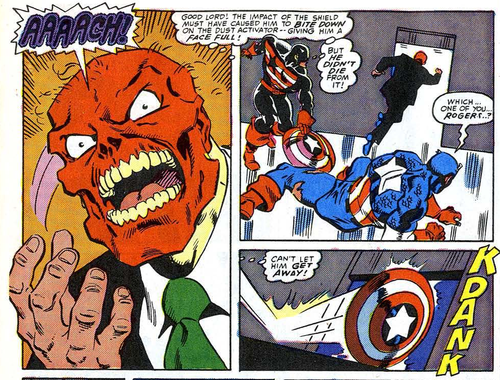
Comments are closed.